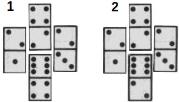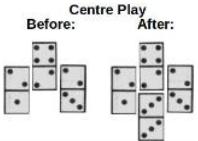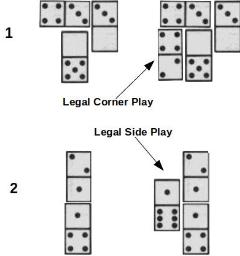Tableaux and Advanced Tableaux
Invented by Howard Fosdick © BestFreeNewGames.com
Here are two modern, positional domino games based on numeric relationships among tiles. Winning relies more on intellect than chance. First, we'll describe Tableaux, then we'll tackle it's more complex sibling, Advanced Tableaux.
Tableaux
Players and Equipment: 2 players use a standard set of 6-6 dominoes, where the length of each tile is double its width. Also, a cribbage board for easy scoring.
Objective: To win the Game by being the first player to score 121 points across as many hands (deals) required.
Start: All tiles are placed face down and shuffled. Then each player draws 4 tiles to start. Remaining tiles become the face down drawing stock, or boneyard.
Select one tile from the boneyard as the starter. Place it face up vertically between the two players, in the playing area or tableaux.
Players decide who goes first by a random event such as a coin toss or die roll. Following the first hand, the winner of the previous hand always goes first.
Play: In his turn, a player must play at least one tile to the tableaux. If he cannot play a tile, he must pass and scores -3 points.
A player can continue to play dominoes in his turn as long as each domino scores points.
Play of any doublet also allows a player to continue his turn if he can (regardless of whether the doublet scores points).
If a player is able to play and score all 4 dominoes in his hand, he draws 4 more from the boneyard and continues playing tiles as long as each one scores (or is a doublet). Playing all 4 tiles in this manner is called a play-through.
After a player completes his turn, he draws tiles from the boneyard so that he holds 4 tiles for his next turn.
Permissible Plays: There are only 3 legal plays in this game. Each is based on the positions and numbers on the tiles in the current tableaux.
1. The Side Play
The side play involves placing a tile at staggered side position to a tile already in the tableaux. Numbers must match as in these examples:

Examples #1 and #2 - The side play tile may be placed on either side
of the 4-2 (at the player's option), but it must be staggered relative
to the 4-2. The connecting numbers must match (here that connecting
number is a 2).
Example #3 - Any matching tile can be used in the side play (here it is a 2-6).
Example #4 - This side play connects to the digit 4 on the 4-2 tile.
A side play scores 0 points, but it does fulfil the requirement to
play at least one tile in a player's turn (thereby avoiding the -3
point penalty for passing).Example #3 - Any matching tile can be used in the side play (here it is a 2-6).
Example #4 - This side play connects to the digit 4 on the 4-2 tile.
2. The Corner Play
For two staggered tiles in the tableaux, there are two positions where a corner play is possible. In this example, X and Y mark these two positions:

Thus, a corner play means positioning a half-tile next to two tiles already in the tableaux. The half-tile thus positioned must equal the sum of the two half-tiles at its flush right angles.
Given the two tiles above, any tile positioned at X would have to be a 5 spot (since it must equal the sum of the two flush half-tiles, 2 + 3).
The half-tile position at Y would have to be a 6 (since it must equal 4 + 2).
Here are five example corner plays:

Example #1 - Placing the 1-5 tile makes a corner play. The 1-5 meets
the requirements because its 5 matches the sum of the two flush
right half-tiles (2 + 3).
Any 5 suit tile would work for this corner play. It scores the player a number of points equal to the total of the matched pips: 5 points.
Example #2 - The corner play tile may be placed in either of two physical positions, whichever the player desires.
Examples #3 and #4 - These examples show a corner play off the Y corner. The 6 on the 6-4 equals the sum of 4 and 2, the flush right adjacent numbers. This play scores 6 points.
Example #5 - This shows how the player might add another tile to Example #1 for a second corner play. Adding the 3-6 scores 3 points.
Any 5 suit tile would work for this corner play. It scores the player a number of points equal to the total of the matched pips: 5 points.
Example #2 - The corner play tile may be placed in either of two physical positions, whichever the player desires.
Examples #3 and #4 - These examples show a corner play off the Y corner. The 6 on the 6-4 equals the sum of 4 and 2, the flush right adjacent numbers. This play scores 6 points.
Example #5 - This shows how the player might add another tile to Example #1 for a second corner play. Adding the 3-6 scores 3 points.
3. The Centre Play
For tiles in this formation, a centre play means inserting a valid X-Y tile:

The tile played in position X-Y must fulfil either of two conditions:
(1) The number X equals the sum of the 3 half-tiles at flush
right angles to it.
In the example above, X must equal 1 + 2 + 3 = 6
--or--
(2) Both numbers on tile X-Y added together must equal the sum of the 3 half tiles at flush right angles to it.
In the example above, X + Y must equal 1 + 2 + 3 = 6
In the example above, X must equal 1 + 2 + 3 = 6
--or--
(2) Both numbers on tile X-Y added together must equal the sum of the 3 half tiles at flush right angles to it.
In the example above, X + Y must equal 1 + 2 + 3 = 6
Examples of Case 1:

As you can see, any tile having a value of X = 6 completes this centre play. This scores 6 points (X points).
Examples of Case 2:

The first two examples show a centre play completed by inserting the 1-5 tile. The third case shows that any tile with pips totalling 6 will be playable and score here (in this case, the 0-6 domino). Each of these centre plays score 6 points (X + Y points).
Doublets: Playing any doublet allows a player to continue his turn if he can (even the doublet scored 0 points for a Side Play).
A doublet scored for a Corner Play or a Centre Play scores double points. This Corner Play example scores 10 points, double the normal score, because a doublet 5-5 was played:

And this Centre Play scores 12 points, double the normal score, because a doublet 3-3 was played:

Blanks or 0's: Blanks function as 0's (zeros) in this game.
Playing the 0-0 tile allows a player to continue his turn, the same as playing any other doublet tile.
Played in a Corner Play, a blank scores 0 points. This example continues the player's turn but scores 0 points:

Scoring Summary:
| Play: |
Score: |
Continues Turn? |
| Pass |
-3 points |
No |
| Side Play |
0 points |
No |
| Side Play with a Doublet |
0 points |
Yes |
| Corner Play |
Points equal to the sum played |
Yes |
| Centre Play |
Points equal to the sum played | Yes |
| Corner or Centre Play with Doublet |
Double the normal points |
Yes |
End of Hand: After one player goes out and there are no more tiles in the boneyard, the 2nd player gets one final turn if he wants it. Then, the hand ends.
It's also possible for a hand to end when the boneyard is empty, and neither player can play. (Players are not assessed the -3 penalty points for their final hand-ending "pass".)
Tiles the players have left in hand when the hand ends are not scored.
End of Game: It's convenient to use a cribbage board to track scores during play. The first player to achieve 121 points across hands wins.
-----------------------------------
Tips for Play: This challenging game rewards forethought. The highest scores result from stringing together a series of scoring plays. Playing through all 4 tiles in hand leads to high scores, as does optimal play of doublets for double scores.
Place your corner plays flush to existing tiles to deny your opponent a corner play on his turn.
*** The Finer Points ***
Legal Plays: As long as you fulfil the requirements for a valid Side, Corner, or Centre Play, it is perfectly ok if you play tile a that touches flush against a non-matching half tile:

Illegal Plays: Side Plays are not permitted in any location where a Corner Play is possible, nor are Corner Plays permitted in any location where a Centre Play is possible.
These two examples illustrate. Positions A, B, C, and D allow Side Plays. Positions X and Y only permit Corner Plays. Position Z can only be a Centre Play:

Dead Positions: Some Corner Play and Centre Play positions are never playable. This is because the sum of the half-tiles at the flush right angles is too high.
Position X is not playable in these Corner Play and Centre Play scenarios because no domino can fulfil the necessary conditions to make the play:

------------------------------------
Tableaux 99: The Advanced Game --
Seeking a greater challenge? Try Tableaux with a 9-9 set of dominoes. Only two Tableaux rules change:
- Each player's hand contains 5 tiles (instead of 4)
- First player to 361 points wins (3 traverses of a 120-peg cribbage board)
-----------------------------------
License: Feel free to print, copy, and distribute these rules, so long as you retain this paragraph. Invented by Howard Fosdick © 2023, distributed under Creative Commons License CC BY-NC-ND. HOME